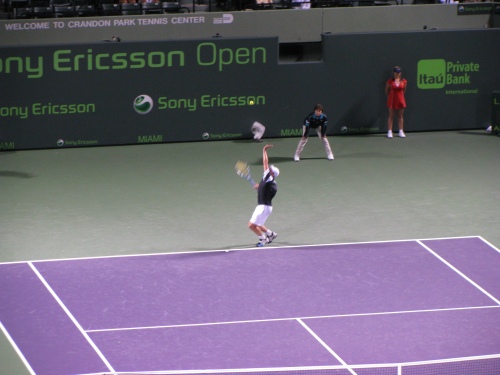It’s Friday evening, and Miami is streaming through the gates of the Sony Ericsson Open. We’ve fled downtown, its half-built condominium towers, its cranes idled by the real estate bust. As we walk through Key Biscayne’s Crandon Park, site of the tournament, a breeze blows through dense groves of palm trees, some of the fronds burned yellow and brown by the subtropical sun.
Up ahead, Bud Collins is standing in the middle of the path, flogging copies of The Bud Collins History of Tennis, his encyclopedia of the game. He’s waving his opus above his head, calling out to passersby like a flea market peddler. The woman next to him is laughing. He seems to be enjoying himself, chuckling at this mildly absurd spectacle.
Caroline Wozniacki d. Jelena Dokic, 6-3, 5-7, 6-2
My first stop is Court 2, Jelena Dokic vs. Caroline Wozniacki. Dokic has just evened the match at a set apiece. Nick Bolletieri is sitting in the stands, shaking hands, greeting people. I get the sense that the pro game’s coaches, agents, and administrators comprise a relatively small circle of mutual acquaintances. The big tournaments are their reunions.
Dokic plays on the knife’s edge. When she throws her entire upper body into her forehand and drives a winner through the court, the psychic rewards must be great. Is there anything more satisfying than pounding the ball past a hapless opponent? But if she’s not playing at her peak, if her timing is the least bit off, the costs of this strategy can be high. And in the third set, Dokic starts to pay the price.
“Concentrate, c’mon, baby,” Bolletieri shouts from the stands. It’s two games all. Wozniacki breaks Dokic to go up 3-2, then holds, 4-2. Dokic continues to pound the ball with grim intensity. She looks angry, a little scary, actually, but she also seems fatigued and frustrated by Wozniacki’s defense. Wozniacki takes Dokic’s hard flat balls, and sends them back deep, with plenty of air and topspin. Dokic struggles to sustain her ground assault for more than six or seven strokes, and sooner or later, makes an error.
At 5-2, Wozniacki serves for the set. Dokic takes the game to deuce, but Wozniacki gets match point with an ace, a heavy slice out wide. Dokic misses the next return. Wozniacki takes the match.
Gilles Simon d. Lleyton Hewitt, 6-1, 6-2.
Hewitt may never again contend for the big titles, but he still possesses the tennis mind that helped him compensate for deficits in size and power to reach number one in the world and claim two Grand Slam titles.
In the fourth game of the second set, Simon and Hewitt engage in a long cross-court rally. Hewitt mixes in a slice down the line. Simon gets there, but the change-up elicits a short ball. Hewitt is at the net. He hits a delicate drop volley winner.
Hewitt saves his first match point with a similar display. He drives a cross-court backhand deep into the corner. Simon scrambles, rips a backhand cross-court. But Hewitt is waiting at the net. He hits a backhand drop volley. The ball dies. The crowd gasps.
The problem for Hewitt is that he misses too many easy balls. Is that the beginning of the end, when you can still do the spectacular, but struggle with the routine?
Nadal/Lopez d. Brunstrom/Rojer, 6-2, 7-5 (5)
The Grandstand is packed. Of the four players on court, only Nadal has a singles ranking inside the top-200. Brunstrom and Rojer fall behind early in the second set, but eventually take it to a tiebreaker. They fall behind there, too, then rally. At 6-5, Nadal brings down the hammer. He fires a serve into Rojer’s body. Rojer tries to get out of the way, but pops it long.
After the match, a crowd swarms Nadal as he leaves the Grandstand. Brunstrom’s and Rojer’s exit is unheralded. But they leave the court with a few thousand dollars in prize money and some memories for the scrapbook. Brunstrom aced Nadal at least twice, and he broke Nadal’s serve by punching a textbook volley behind one of the best movers in the history of the game.
Andy Roddick d. D Junqueira, 6-1, 6-1
I’m sitting in the 400 section of Stadium Court, as high as you can go. But the view is good. You get a feel for how the point is unfolding. What you don’t get from up here is a sense of how hard these guys hit the ball. The balls look clean and slow-moving, not too different from the balls a club pro might feed his or her students. Even so, when Roddick drops a 130-mile-an-hour service bomb out wide, section 400 snaps to attention. We know we won’t see this at the local club.

Roddick brings the heat.
Junqueira doesn’t have a chance on Roddick’s serve. His chances on his own aren’t much better. Late in the second set, Junqueira’s goal is no longer to win, I’m guessing, or even to make it competitive. He’s just hoping to make the match last an hour. He comes up short. Roddick takes the match 6-1, 6-1 in 56 minutes.
Roddick’s match is the last of the night. The scene in the parking lot is predictably chaotic. I wait an hour and a half for the bus back downtown. But I can’t complain. Twelve hours ago, I was boarding a plane in the Northeast, still firmly in late winter’s grip. Now I’m here in short sleeves, comfortable in the gentle Miami night. My seasonal affective disorder is on the mend.
More tennis tomorrow.

